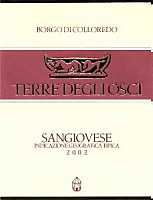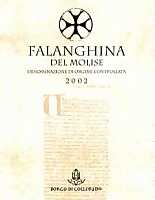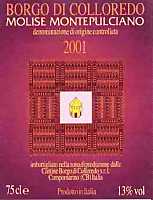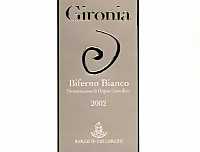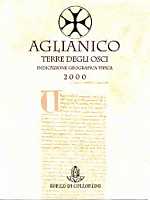|
The enological fame of Molise was known since ancient Roman times and Pliny the
Elder, in its monumental Naturalis Historia, wrote about fertile slopes
facing towards the Adriatic sea, near the ancient town of Cliternia, with a
mild and tempered climate particularly suited to the cultivation of vine. In
this area is located Borgo di Colloredo winery. In the 1960s, Silvio di Giulio,
founder of the winery, bought an estate near Nuova Cliternia, forty five
hectares of fertile land and particularly exposed to sun rays in a hill facing
towards south-east, towards the Adriatic sea, a place full of promises for the
best conditions of vine cultivation and wine production.
|
|  |
| View from a Borgo di Colloredo's vineyard |
|
Slvio di Giulio, whose origins are from Tollo, Abruzzo, aware of the long
family experience and of the historical wine traditions of its home land, he
always had the idea of starting a project about specialized viticulture and,
after having bought the Nuova Cliternia's estate, his dreams could finally turn
into reality. The first project of the winery is dated back to 1968 and it was
completed within the end of the 1970s. Passion for vine and wine was passed to
his sons Enrico, winemaker, and Pasquale, agricultural cultivation specialist,
who continued running the winery with enthusiasm.
Di Giulio's brothers had the idea of introducing new local vine species in
their winery and, at the beginning of the 1990s, they started the winery's
restoration. This renewal introduced new vine species, including the white
berried grapes Garganega, Malvasia Bianca and Falanghina, as well as the red
berried grapes Aglianico, Merlot and Cabernet Sauvignon. The winery is also
involved in experimental cultures and productions by using Chardonnay and
Cabernet Sauvignon grapes. During the winery's restoration, the original
machinery were renewed and introduced new ones according to the modern wine
technologies. However di Giulio's brothers paid particular care to keep the
precious cultural and traditional heritage of their lands whose history passed
on to us up to nowadays. Also favored by the illustrious past of those places,
di Giulio's brothers called their winery “di Colloredo”, in honor of an
ancient building, destroyed in the sixteenth century, where it was subsequently
built Madonna Grande Church having an octagonal base which is part of the
winery's estates. As a matter of choice of the proprietors, the winery is
considered an “open project” for their customers and the public, both for
experts and simple tourists, the winery's doors are always open for them.
According to a wider and continuing renewal project, the winery is working on
the existing vineyards maintenance as well as planting new ones in the aim of
starting a new project about viticultural zoning to be completed, according to
the winery's plans, within four years. This project is based on the evaluation
of the functional properties of the land while paying attention to the
microclimate as well as to the different vine species cultivated in the
estates. The goal of the project is to discover the potentialities of the land,
related to every single vine species, in order to make wines whose quality is
the result of the harmonic relationship between land and vine. This is an
important leap forward in the aim of obtaining higher quality products, in
respect to the properties and characteristics of the territory. All the factors
influencing wine cultivation in relation to the effects and the characteristics
of the territory are being analyzed, in order to better apply the best
conditions capable of optimizing every resource. The project will have its
natural development in the control of the results which make, as a matter of
fact, the real goal of this research.
The winery currently has a total capacity of 15,000 hectoliters
(396,258 gallons) and is run in respect of quality and by the high level of the
technologies used. No matter wine technologies are modern and sophisticated,
this scrupulously meets the best criteria in respect of the typicality of
products: from thermo-controlled vinification of must obtained by soft
pressing, to maceration of must in skins for relatively long times for red
wines, from stabilization to bottling, every phase of the production is
controlled with particular care. Young wines are aged in steel tanks, whereas
Gironia Biferno rosso and Aglianico Terre degli Osci age in oak casks and
barriques.
|
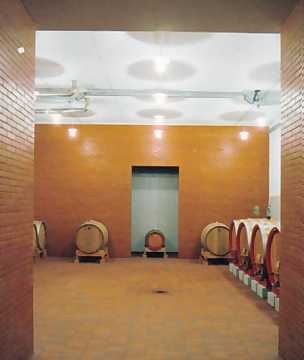 | |
| The cellar. Here wines patiently wait for
time to do its job | |
|
Borgo di Colloredo production offers typical wines from Molise, both DOC
(Denominazione di Origine Controllata) and IGT (Indicazione Geografica
Tipica). Wines produced by the winery are currently exported for 70% in the
European Union and Japan, whereas 20% is destined to the Italian market and
the remaining 10% to Molise. Among white wines produced by Borgo di Colloredo,
it is worth mentioning Biferno bianco Gironia, produced with Trebbiano Toscano,
Bombino Bianco and Malvasia Bianca, an interesting interpretation of this
renowned Molise's DOC, fermented and aged in steel tanks. Also interesting is
Falanghina, one of the typical white berried grapes of the region, aged in
steel tanks. Among white wines there is also a Trebbiano, direct and pleasing,
aged in steel tanks, just like every other white wine produced by the winery.
Among red wines produced by the winery, it is worth mentioning Sangiovese Terre
degli Osci, aged in steel tanks, and Montepulciano, aged in steel tanks as
well, both very pleasing and direct. Certainly interesting is Biferno rosso
Gironia, produced with Montepulciano and Aglianico grapes, aged in cask for
12-18 months followed by 6 months of aging in bottle before being
commercialized. Also Aglianico Terre degli Osci is an interesting and well made
wine, with good body, exclusively produced with Aglianico grape, ages for three
months in barrique followed by a further aging of 4-5 months in bottle.
|


